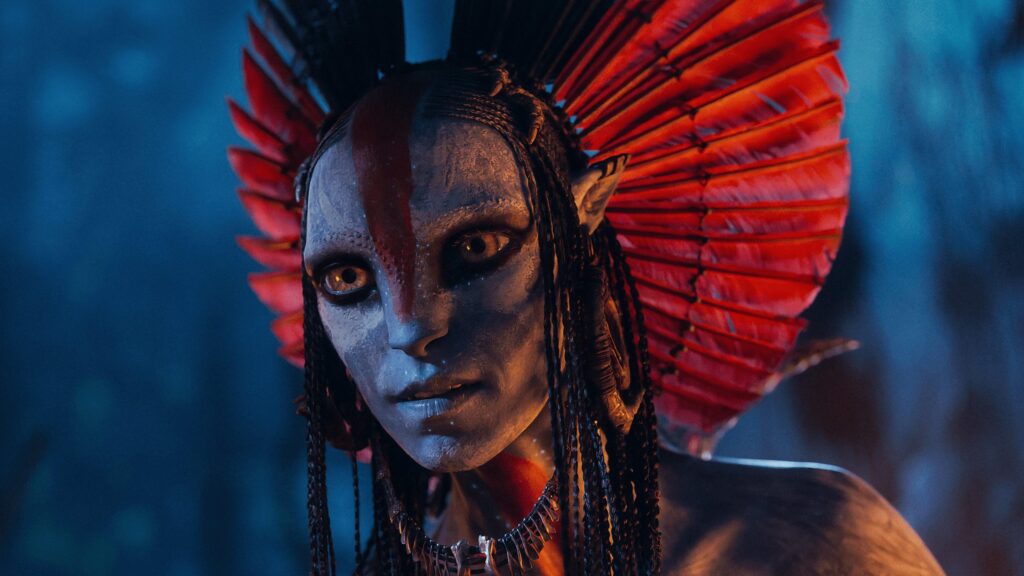Avatar: Fire and Ash
Posted on December 18, 2025 at 5:43 pm
B| Lowest Recommended Age: | Middle School |
| MPAA Rating: | Rated PG-13 intense violence, bloody images, strong language, thematic elements, and suggestive material |
| Profanity: | MIld language |
| Alcohol/ Drugs: | Drugs |
| Violence/ Scariness: | Extended peril and violence, guns, fire, bombs, characters injured and killed |
| Diversity Issues: | A theme of the movie |
| Date Released to Theaters: | December 19, 2025 |

A quick recap: long blue people mostly good, human people mostly not good. Humans from Earth want the resources of the blue people’s planet. The blue people (Na’vi) want to keep it peaceful and pristine. And sometimes the blue people fight with each other. And it takes 3 hours and 15 minutes.
You don’t need to remember every detail of the earlier films; if you have a vague recollection that you liked them, you will be fine because, like its predecessors, the visuals are stunning, the action is dynamic, the story is thin, and the dialogue is painfully basic, just barely enough to let you know who you’re supposed to root for. Cameron, who has said that he makes movies to finance his ocean adventures, loves water, and the water in this movie is simply gorgeous. The long blue people are, too. They all look like supermodels crossed with Mr. Fantastic. So if you did enjoy the earlier films, you will enjoy this one, too.
Next to the visual splendor, the other reason to watch the film is the villain. James Cameron emphasizes that the technique is not motion capture, but performance capture. Every actor playing one of the blue creatures performs every minute on screen, each one’s face covered with dots to guide the CGI. So, all credit to Oona Chaplin, the grand-daughter of Charlie Chaplin and great granddaughter of playwright Eugene O’Neill, for playing Varang, a ruthless bandit queen with magnetically sinuous menace. And with a head like a frilled-neck lizard. She wants to destroy the peaceful community where the hero of the first movie, human turned Na’vi Jake Sully (Sam Worthington) is settled with his wife, Neytiri (Zoe Saldaña) and children, sons Neteyam (killed in the second film) and Lo’ak and a daughter called Tuk. They also adopted Kiri, mysteriously born from a human in an avatar body (the laws of biology as we know it don’t apply here), and they care for a loyal and limber human teenager called Spider (Jack Champion), the son of one of Jake’s most important foes, Colonel Miles Quaritch (Stephen Lang).
Like Jake, Spider is completely at home in the world of the Na’vi, though he has to use a mask to enable him to breathe on the planet. He has no relationship with his biological father. Both of those elements will change over the course of the film, as Jake, Neytiri, and their family have to find a way to defend their community, even after Varang forms an alliance with Quaritch, meaning access to guns.
As this movie begins, Lo’ak and Neteyam are swimming together, at least in a dream of repeated goodbyes. Lo’ak is still suffering from survivor guilt and has a strained relationship with Jake beyond the typical teenage push for independence. Everyone in the family feels guilt along with grief.
There are some powerful emotional themes but they are explored in a not very powerful way. The issue of an outsider giving more powerful weapons to shift the balance of a conflict was explored with more insight in its episodes about the prime directive. Before the next one comes out, maybe they could spend some of the zillion dollar budget on dialogue better than “All this time and you still don’t get it. The world is much deeper than you imagine.” This film is less deep than it imagines. But very beautiful.
Parents should know that this film has extended peril and violence, including arrows, knives, guns, and explosives. Characters are injured and killed. There is a lot of intense family drama, with issues of biological and adoptive families. The military-industrial complex from Earth is represented by rapacious, murderous business employees and soldiers. Scientists are more compassionate. There is a non-explicit sexual situation and some sensual touching.
Family discussion: What are the options for a community being attacked by enemies with vastly superior weapons? What makes Spider feel accepted and what makes him feel like an outsider?
If you like this, try: the previous “Avatar” movies







